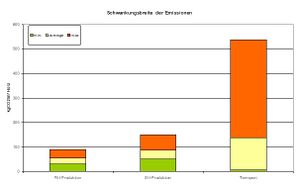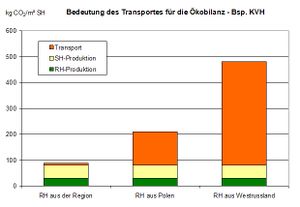Climate action with Low Carbon Timber
Transport distances as an indicator of climate-friendly low carbon wood products
Climate change is among the most crucial political, economic and social challenges of our time. We must put in all our efforts to reduce gas emissions, achieve ambitious goals and prevent economic damage whenever possible. Wood is a renewable resource and an important step on the way towards the above goals, but nevertheless it is important to assess the carbon balance of a finished wood product. The positive effects of carbon storage of such a product should not be outweighed by high emissions.
Climate-friendly manufacture of wood products is mainly about two main points:
- CO2 optimisation of timber industry techniques (lifecycle phase A3)
- CO2 reduction by means of cutting down on excessive non-productive transport (lifecycle phases A2 and A4).
For a number of reasons, shortening the transport should be the key and central action.
I. On the national, EU and global scale, transport has a large and growing negative effect on the environment:
- Globally, transport ranks third among the causes of climate change.
- Transport is the only sector in the EU which has despite all the efforts and measures such as bio-fuel, EURO-Norm and e-mobility not managed to decrease its CO2 emissions but has increased them instead. The main reason is the rebound effect stemming from the fact that every increased-efficiency procedure is even more carbon-intensive.
- Emissions in freight transport have been on the increase in the recent decades and are forecast to continue their climb in the future.
- The share of freight vehicles (in road transport) has gone up dramatically over the last decades and will remain high in the future.
II. Transport (if it does not decline) is the main component of the environmental performance evaluation:
- Fluctuations or deviations of various timber industry companies with regard to production-technical emissions are mainly comparable and minor averaging at about 25% (according to a 2012 study by the Thünen Institute). This means that differences between various providers are minimal and the potential of reducing carbon footprint is small.
- The differences in transport distances travelled for the supply of raw materials and freight routes of the supply chain may amount to several hundred per cent, as shown in Fig. 1. This means that transport has a higher impact on the carbon balance of equal wood products tan production processes.
- Emissions resulting from transport take up a much higher percentage than any other type of emission, as shown in Fig. 2 based on a real case of round wood sourced for construction timber in Germany.
- The share of transport in the carbon balance keeps increasing as the environmental impact of production improves (not due to ecological motives but for cost optimisation).
III. Of all carbon balance components, transport can be changed most efficiently and most easily in a short term:
- • Of all the factors affecting emissions, the flow of goods in the manufacturing chain can be changed and controlled with the quickest and most efficient effect. A change in demand can easily affect a batch of deliveries, directly changing delivery terms and conditions and reducing the carbon footprint. On the other hand, production techniques will not be changed on the basis of individual inquiries.
- Eine Änderung der Produktionstechnik zur Minderung der CO2-Emissionen ist zudem in der Regel mit außerordentlich hohen Investitionen verbunden, die ein Unternehmen nicht bei einem geringen Stimulus ohne weiteres durchführen wird. Das heißt, an diesem Hebel anzusetzen, verspricht wenig Aussicht und hat deswegen keine Steuerungswirkung, die mit entsprechenden Maßnahmen ja gewünscht ist.
- Hinzu kommt, dass die individuellen betriebsspezifischen produktionsbedingten Emissionen nur sehr aufwändig zu ermitteln sind. Der Betrieb würde eine eigene Ökobilanz benötigen, die sehr teuer zu erstellen ist und somit gerade kleine und mittelständische Betriebe benachteiligen würde. Zudem würde ein entsprechendes Instrument dann gar nicht akzeptiert und angewendet, so dass die beabsichtigte Wirkung verfehlt würde.
- Die Transportkosten (z.B. bedingt durch Treibstoffkosten oder Steuern) selber sind bislang kein Steuerungsmechanismus, da sie in der gesamten Kostenstruktur einen sehr geringen Teil ausmachen. Zudem spielen andere Faktoren für die Wahl des Verkehrsmittels sowie der Herkunft eine größere Rolle.
In diesem Sinne sind Holzprodukte, die nachweislich regional mit überdurchschnittlich kurzen Wegen hergestellt worden sind, 'Low Carbon Timber' Produkte.
Inhalt: G. Bruckner und P. Strohmeier für HOLZ VON HIER.


